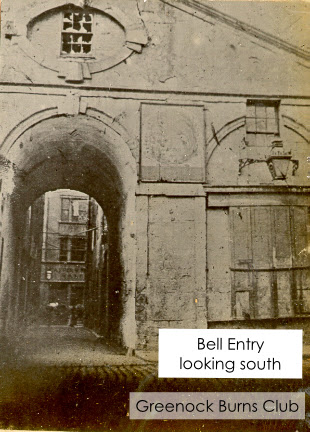The increase in trade across the Atlantic with America in the 1740s and 1750s made the need for more storage space for imported goods in Greenock particularly important. The cellars (as the warehouses were called) that existed, did not provide enough accommodation for the rise in the amount of goods coming into Greenock. Merchants in Greenock, as well as the Glasgow tobacco merchants urged the Magistrates and Council to build new cellars near the harbour.
The Town Cellars, as the Bell Entry was originally termed, were constructed in 1750 at the entrance to the West Harbour near the bottom of the Vennel, a major street in Greenock at the time. The stone for the cellars, (and many other buildings in Greenock at this time came) from quarries at Finnart – in the west of the town, which at the time was way out in the country.

Picture source - Greenock Burns Club
A few years later many of those who worked around the harbour decided that a clock was needed in the area as well as a bell to indicate starting and finishing times for work. In the book “Views and Reminiscences of Old Greenock” (James McKelvie & Son, 1891), is an extract taken from local council minutes of November 1754 – “It was proposed that a Bellhouse be erected upon the roof of the New Cellars, to be so executed as that a clock may be placed therein”. A wooden bell tower, which some say was designed by James Watt’s father (a member of the council at that time), was erected above the archway which led to the passage through the building and a bell and clock incorporated. The place then got the name “Bell Entry”.
The bell was purchased in Glasgow and, as recorded in “Historical Sketches of the Town and Harbours of Greenock” (Dugald Campbell, 1879) weighed 2cwt 3qrs and 2lbs and cost 1s 2d per pound, the total came to £18 1s 8d”. The clock, with four hands was bought from Jordan watchmaker, Glasgow. This was the only public clock in the town until the spire of the Mid Parish Church in Cathcart Square was erected in 1787.
The passageway through the building had a very practical use. An idea of why they were built in such a manner can be seen from Greenock Merchant James Scott on obtaining land in the area just before the town cellars were built, petitioned the Magistrates and Council – “In the event of Tobacco Cellars being built – there shall be a gate in the middle of the wall (enclosing the ground) through which the said James Scott and his foresaids shall have liberty to roll their tobacco into the closs belonging to the community immediately at the back thereof, and of dressing the same there…”. At this time most cargoes were transported and stored in wooden barrels.

Picture source - Greenock Burns Club
The bell and clock were in use until 1839 when the bell tower was removed as it deemed dangerous. The Bell Entry had a number of other uses over the years as more warehouses were built. For a while a loft in the eastern part of the building was used as a chapel for the Seamen’s Friends’ Society. Over the years as can be seen from these old photographs, the building became very run down and in 1880 the western part of the Bell Entry was demolished in the name of town improvements.
Curiously, in 1880 when a new badge of office (costing £60), was being designed for the town’s Dean of Guild (the council official responsible for buildings in the town), it contained an image of Art on one side and an image of the Bell Entry on the other. On presenting the badge to the Dean of Guild, Allan Bertram Smith, the Provost, Dugald Campbell, said of the Bell Entry that – “it was a relic of Greenock 150 years ago” and that he hoped that the Dean of Guild “will take measures, if not too late, to preserve a more substantial relic than even the view of it on the badge.” The newspaper article goes on to say, “There are surely some of the old stones, which could be retained and placed, say somewhere about the New Corporation Buildings or better still, they might be presented to the Watt Monument Committee, if that somnolent body has not breathed its last.” Another newspaper article commented on this badge being given to the Dean of Guild – “If every member of Council is to receive a golden badge, the sooner we see about the importation of Californian mines over to the old country the better”.

Picture Source - The Watt Institution
Over the years, the Bell Entry changed from being a proud testament to Greenock’s trade to becoming an overcrowded and unhealthy place. Crime was rife – assaults, theft, prostitution and shebeening (sale of unlicensed alcohol) just some of the examples. Fortunately today there are still images of the Bell Entry as it was in its heyday.




No comments:
Post a Comment
Your comments are very welcome.